It is a rare occurrence when a shoe actually delivers on the enormous amount of hype it comes backed with. For a shoe reviewer, that is once in a thousand moment, something which is fleeting and to be savored. Because that is the time when the shoe in question is undoubtedly in its finest hour; and even if there were some minor shortcomings, they are squashed under the impressive ride experience. At the same time, one realizes the fragility of the moment, wondering if the stellar act is ever going to be repeated, and whether the next shoe can better a past version of itself.
The Hoka One One Clifton is one such example of what we’ve just finished describing, and it is all what the brand claims it to be. The ride is superlative, delivering cushioning in a way which no other shoe with a full-foam midsole does.
You have to give massive props to the guys who started Hoka, for they did so in a very unlikely time. The year 2009, when minimalist shoes were all the rage; businesses selling pancake flat, zero drop running shoes witnessed growth numbers which could put viral YouTube kitten videos to shame. But this wave subsided as quickly as it swelled, and ultra minimalist shoe models fell by the wayside, much like abandoned motels on an once bustling motorway.
But for Hoka, it just signaled the beginning of a brighter future.
Frenchmen Jean-Luc Diard and Nicolas Mermoud, founders of Hoka, are enterprising outliers, for they did something which they thought was right, with scant regard for what the current market trend was. In what was a glaring dichotomy of ideology, these gentlemen along with ex-coworkers Christophe Aubonnet and Sebastian Mazars developed the earliest Hokas (Mafate) with oversized midsoles, initially targeted at the very community the founders were long part of – ultra runners. They pitched the shoe calling out its two very important, and distinct aspects. First of which was being able to offer maximum protection by means of a foam midsole possessing unprecedented thickness. And second, its unique outsole geometry with a pronounced heel and toe spring meant to economize foot strike and overall gait cycle.
But the minimalist boom wasn’t just for nothing . A low heel to toe drop midsole continued to remain relevant, a likely enduring legacy of the short era. Hoka chose to combine low heel drop with their peculiar looking oversized midsoles, which today the brand calls as a ‘blend between minimalism and maximalism’. Starting from its initial base of early adopters, it continued to gain upwards traction towards a higher level of mainstream awareness.
There are mentions of wide bodied powder Skis as being one of Hoka’s design inspirations, and we see no reason to disbelieve that. After all, a quick search revealed founder Jean-Luc Diard to have a number of patents in Ski design.
What does Hoka One One mean? This phrase is borrowed from Maori (New Zealand) language, but there seems to be some confusion about what it actually means. Versions like ‘it’s time to fly’, or ‘it’s time to fly over the earth’ are the oft chanced upon interpretations, but we decided to look it up in an online Maori dictionary. The word ‘Hoka’ translates into soar or fly, with ‘OneOne’ being earth or soil. It would seem that ‘Soar over earth’ is a literal translation, but hey, we don’t know Maori. We get a fair number of readers from New Zealand, so it’ll be great if someone from middle earth could let us know whether our assumption holds water.
Deckers corporation (Teva, Uggs) bought the Hoka brand in September 2012, and that was indeed great foresight. The brand is growing at an amazing pace, and shoes like the Clifton only help its cause. Runners are not the only ones who’ve noticed; other brands are already making inroads into this new shift of footwear trend. Brooks have their full foam Transcend, doing away with their Gel inserts. New Balance has jumped into the game with Fresh Foam 980 and upcoming Zante; and Asics is also looking at the Hokas for inspiration, with ‘Fluid Foam’ based excel 33-M nearing its retail debut.
That was a brand introduction long enough, and time to get into the actual review. So what are we dealing with here?
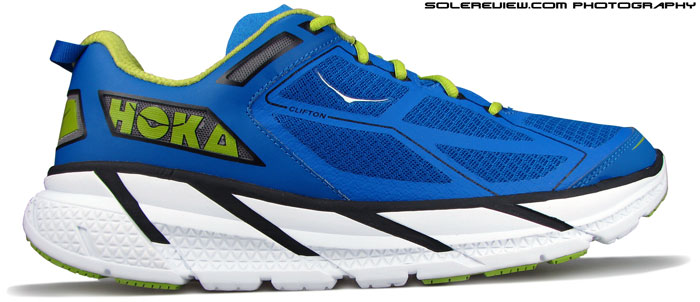
The midsole looks jumbo thick, but a quick comparison of stack heights across brands unveiled an unexpected finding.
Let’s move things into gear with a quick smattering of basics. The Hoka (road running) construct has four characteristics or sub-categories which attempt to draw invisible lines between its similar looking maximalist offerings. These happen to be ultrasize, oversize, early stage metarocker and late stage metarocker, which is also known as the balanced metarocker. These features show up in pairs on Hokas, like the Clifton being an oversize with early stage metarocker.
And what exactly do these mean in English? The ‘ultra’ and ‘over’ prefixes refer to midsole thickness, or in running parlance, stack heights. Ultrasize is the big daddy here, with midsole heights going upto 35mm in the heel and 31mm in forefoot. Oversize is the shorter denomination, with sole heights being capped at 30 mm under the heel and 24 mm in the forefoot.
These don’t mean anything as standalone numbers, so we’ll try to offer you some perspective. Shoes like the Nimbus 16 have a heel stack of 32 and forefoot of 22, which makes a section of the shoe higher than Hoka Clifton, which comes in at 29 mm heel and 24 mm forefoot. Shoes like the Saucony Ride 7 would be lower, but yet not very different in thickness (from a Clifton) with a 28 heel and 20 forefoot.
The Hoka Clifton, like most of its ilk, come with exaggerated midsole walls which also function as support structures over the upper. This gives the impression that the Clifton has a midsole of monstrous thickness. But if you compare stack heights quoted in above mentioned examples, the shoe is more or less the same as many traditional neutrals. But mind you that we’re just talking about vertical thickness and not volume. When it comes to sheer volume, Hoka trumps them all.
The term Metarocker (MR) simply refers to the midsole shape in the forefoot. Hoka comes with a noticeable raise of heel and forefoot areas, hence the use of word ‘rocker’, much like a chair by the same name. This design element is meant to smoothen transition/gait process through delayed foot-strikes and supported toe-offs. The ‘meta’ part is a shortened form for Metatarsus, a group of bones extending from midfoot to forefoot. An easier way is to follow the foot arch; the metatarsals heads start right at the end of the arch curve. This area is where the foot flexes during toe-offs.
An early stage metarocker would mean that the Hoka in question would have the midsole starting to rise up right from the Metatarsal head area or even a little before it; hence the word ‘early’. This causes the foot to roll earlier towards toe-off by help from the upwards midsole curve. In contrast, a late stage metarocker would have a smaller area of curved raise. This means that forefoot transition will feel a bit ‘flatter’ than early stage MR and produce a little work for push-offs.
The simplest way to tell an early stage MR from a late stage MR is to look at the section of midsole which is in full contact with the ground. If the flat part extends further into the forefoot, then it is late stage. If the midsole starts rising upwards right from the midsole-forefoot meeting point, then that’s a dead ringer for an early stage metarocking Hoka.
The Clifton belongs to the category of oversize early stage Metarocker shoes, making it one of the less extreme Hokas. It won’t be wrong to say that the Clifton is the sweet spot of all what Hoka has to offer, extending its appeal to a larger crowd of neutral, road runners. A year or two down the line, this shoe will be seen a major milestone in the brand’s history, one which helped it cross the bridge to mainstream.
Fun fact: While Hoka’s unique design which combines different construction elements is patented, there exists precedence for rocker design in therapeutic footwear, as evident from this patent. A part of the Meta Rocker’s feature is also found here, in another patent for a shock absorbing medicinal shoe.
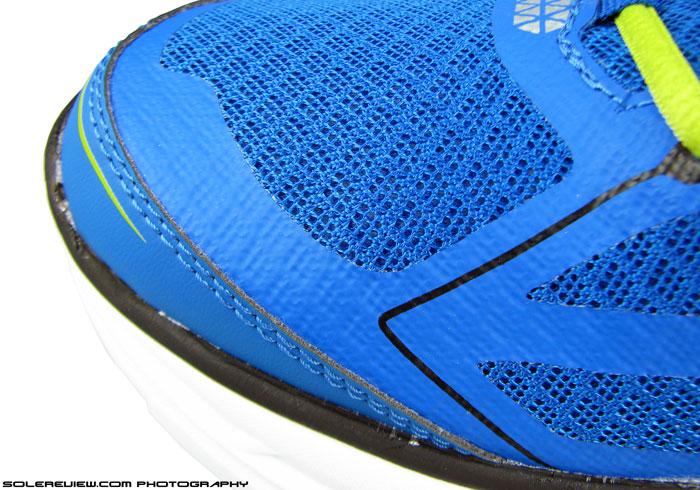
And stitch-less overlays too. There’s an area painted silver in top right hand corner, and that’s not reflective.
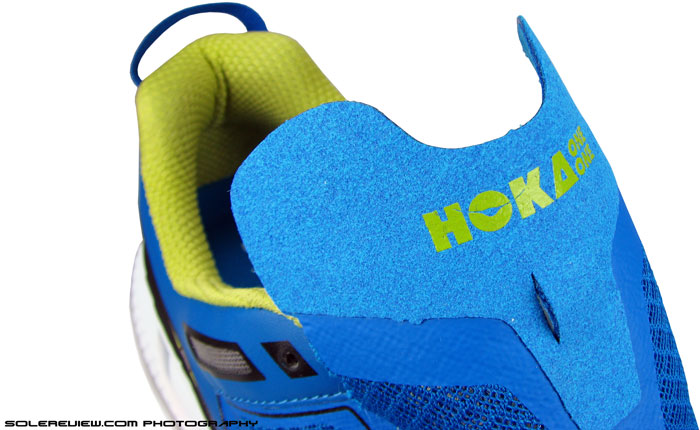
Tongue has no foam padding, and the top synthetic nubuck part comes with its own idiosyncratic behavior. Hint: colored socks.
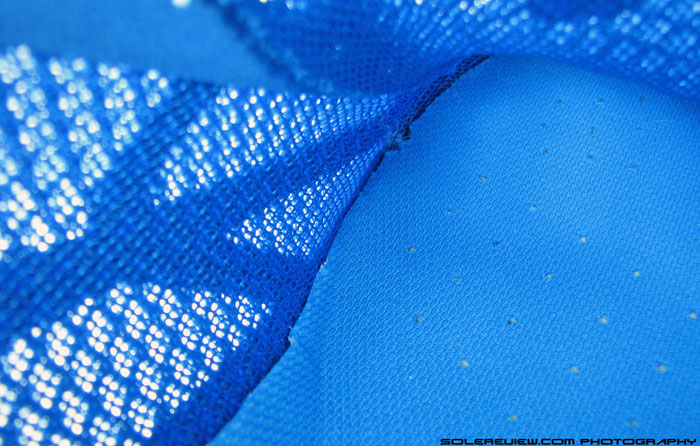
The mesh is unlined, which reduces weight and enhances ventilation. Look at all that light streaking in!
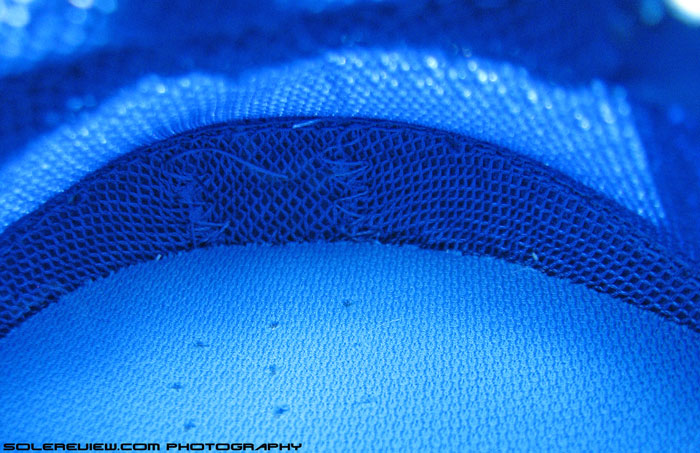
This is how the toe bumper looks from the inside. There’s a seam (not in frame) near the lacing point which makes barefoot usage an issue.
Upper construction is fairly simple. Regular synthetic leather overlays cover the toe bumper and rear-foot sections, and a breathable air mesh keeps things going in the fore and mid-foot. The mesh lacks any stitched-on layers, so support comes by way of fused overlays in a tonal color. Tongue is an unpadded deal, made of the same upper mesh and uses a softer, synthetic nubuck on its lip. Lacing is what’s commonly seen, medium thickness laces threading through punched eye-holes.
Collar is foam packed and lined with a soft-to-touch fabric, and a rather large pull tab is fixed just beneath the Achilles dip. On the outside, there are decorative windows with mono-mesh, with the Hoka text welded on lateral side and a panel with the ’soaring bird’ logo on the heel.
Clifton comes with no reflectivity. There’s a printed patch of silver on heel and toe box, but they are just that – paint. If those areas were supposed to be reflective at night, then they fail to do so.
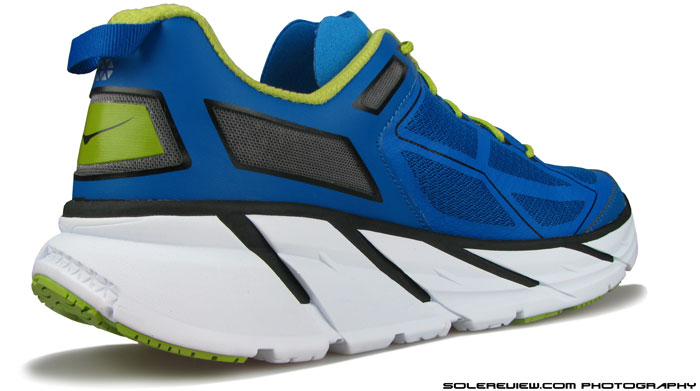
The black part looks like it’s overlaid over white. But unlike the Hoka Conquest, this isn’t the case here. The entire midsole is a single unit.
The lower half is a compression molded, single piece midsole. Rear-foot thickness might seem humongous, but in actuality it’s the high side wrap walls playing an optical trick. The walls around the heel shoot up around 17mm higher than the actual foam thickness, forming a kind of foot cradle or bucket which Hoka calls Speed Frame . When viewed from the side, it looks as if a separate, black layer of foam is stacked on white. But this happens to be just paint, and very neatly done at that. The Clifton design has an unmistakable visual tie-in with the more expensive Conquest, which by the way, does feature two different layers of midsole foam.
Angular grooves are cut into the sides, filled with the same black paint; besides giving the shoe an aesthetic depth, we discovered that the grooves are actually functional. We’ll detail this in our midsole performance breakout when we come to it.
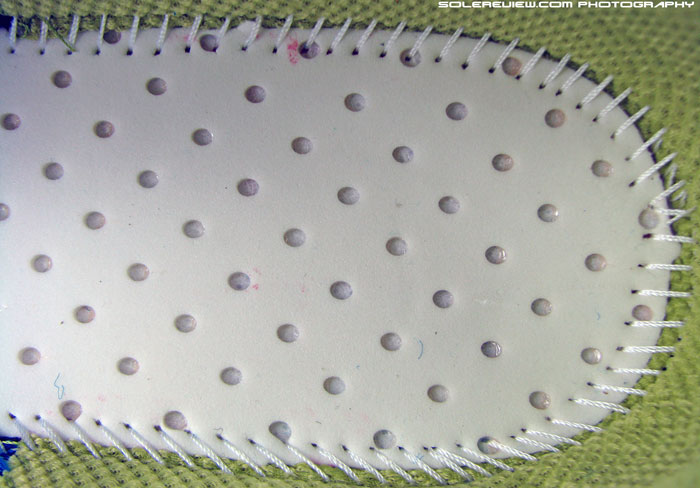
The riddled-with-hole strobel seems to be a carry over from Hoka’s water drainage equipped models. The Clifton does no such thing.
Insole is made of very thin molded EVA which is removable. Its heel is adorned with Hoka branding and decorative printing which seems to be inspired by Ta’ Moko (Maori face tattoo), a nod to Hoka’s etymology. The footbed is generously perforated, and so is the Strobel it sits on. It is quite possible that these components are borrowed from other Hoka models (eg: Conquest) which feature water drainage. But as far as Clifton is concerned, these holes don’t serve any functional purpose.
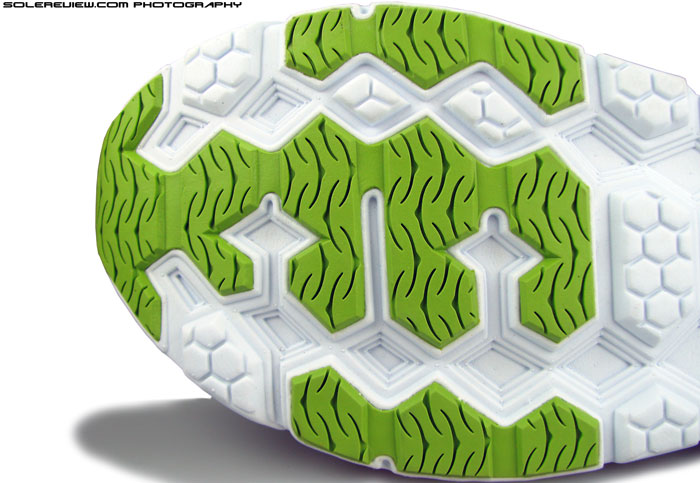
Hoka bird logo grooves also serve as ground traction. Rather symbolic, considering what Hoka One One means.
The outsole has a fair bit of rubber coverage, considering the shoe’s overall weight. The heel area has some, and the forefoot is generously covered. The rubber is thin and soft, and its capacity to withstand wear depends on your footstrike. If you’re a rear-foot striker, wear happens on the initial contact area while forefoot rubber remains relatively unfazed.
The Clifton’s crown jewel is its superlative ride, but we’d like to start with our thoughts about its upper. If there’s anything to be fixed, that happens to be only on the shoe’s upper. We were hoping that the Hoka Clifton will score much higher (90%+ out of 100), but a few upper imperfections proved to be its undoing.
Cutting to the chase, the fit could be much better. Starting with the forefoot, the upper feels snug. Not a bad thing, except that there are undesirable pockets of tightness. To be specific, the upper presses down on the pinky toe area, hemming it noticeably more than rest of the forefoot. This is something which potentially could be unbearable in wider feet. Even for regular forefoot width, this cramps the foot’s ability to splay.
This is a shortcoming for a shoe meant to go the distance in, where the foot tends to expand slightly over long miles.
In a stark mismatch of how the forefoot felt, upper midfoot is more easy going, so much so that when you tug on the laces, both sides of the upper come super close. You’d think that if it weren’t for the tongue, the twain would have met. There’s only one bright side to this; the side panels come so close that they keep the ungusseted tongue from sliding.
Given this inconsistency, overall pattern dimensions and placement seem to be bit off and is an area which can be improved upon. The midfoot panel’s also missing the last eyelet – and not that this is a Hoka thing. We’re also currently testing the 2 mm drop Huaka, and that shoe has additional eyelets for an optional level of cinching. This leads to the quality of Clifton’s collar fit being less ideal than what it should be. It is plush enough, but you’re left wanting for a higher level of grip around your ankles.
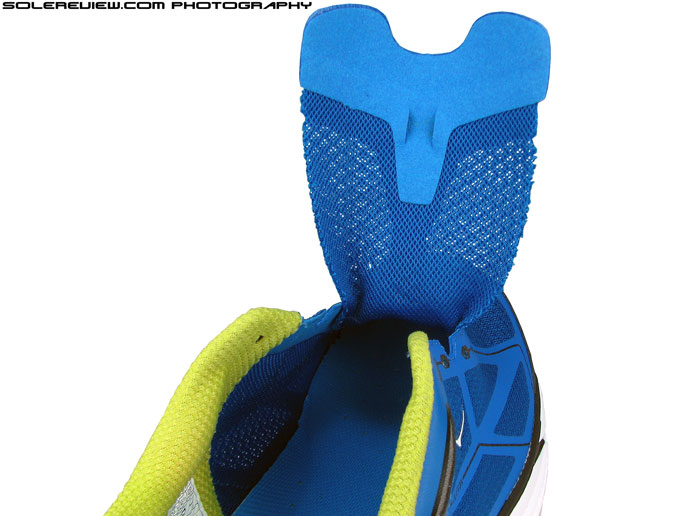
Tongue is super thin, and not the ideal accompaniment for an oversized, super comfortable ride. Pad this thing out, and it will generate another army of Hoka loyalists.
In our opinion, midfoot fit and feel could have been bettered by use of a padded tongue. This would have made the Clifton experience more wholesome, especially when you’re doing your running on cloud like cushioning. A single layer tongue like what’s used on the Mizuno Wave Rider would have been perfect. It doesn’t add much weight, and even if it did, it should be least of Hoka’s concern. The Clifton comes in super light at a mere 236 gms for a US 11, which is much, much lighter than most of the shoes out there. The distance racing adios Boost 2 weighs more than the Clifton, despite the Boost looking malnourished in comparison.
To cut Hoka some slack, we can see where the spartan tongue and tight forefoot fit is coming from. Our guess is that since initial Hoka’s were purpose built for trail running, the fit was customised accordingly to accommodate the rigours of downhill running. That build philosophy might have transferred to this shoe. But then Clifton is an outright road shoe, and trail footwear best practices doesn’t necessarily need apply here.
The lack of tongue padding isn’t the only thing which displeased us. The tip of tongue uses a synthetic nubuck like material, and this transfers colour on the socks. And we’re not talking about running in rains, this happens in absolutely dry weather. The socks turn blue under the area where this material is used. This can only mean two things. Either this material has sub-standard dyeing, or the synthetic nubuck is something on the lines of Tirrenina Suede (adios Boost 2) which has inherent trouble retaining color. If this was the latter case, Hoka should have put in a disclaimer like adidas has.
And in our pair, we found the left tongue to be a bit shorter than the right. For Hoka, it’s another area to keep an eye on.
Toe-box is vertically accommodating, and unlike some shoes the big toe doesn’t stick out through the mesh. There’s a seam where the tongue joins the upper, and this is bit of a bother in a scenario when you decide to run without socks. It feels rough against bare skin, the thick seam rubbing over.
The Hoka sizing chart is same as what’s used in adidas and Salomon footwear. Not a coincidence, since Hoka founders are ex-Salomon employees and it made sense to go with what they were accustomed to. Does that affect the fit? Not in US sizing. A US 10 will equal the same size on a pair of Brooks or Nike in overall length. It is only when you start converting into UK or Euro sizing does it get a bit messy. Hoka (along with adidas and Salomon) prefers to use half UK and decimal Euro sizes when coverting from a full US size.
Here’s a tip. The ONLY true measure of a shoe’s actual length is the JP or CM sizing, which is a simple measurement of the insole (wearable area) from heel to toe in centimeters. So if you’re a JP 29 on a pair of Asics, then a JP/CM 29 on a pair of adidas should do it for you, regardless of what the US, UK or Euro sizing is. This obviously discounts variations in last fits, which can make a shoe tighter or looser in areas other than sheer length.
From a practical usage standpoint, the Clifton’s sizing runs true, leaving you with a small measure of width between the toe and shoe tip.
No full foam midsole-d shoe has felt as smooth and well rounded as the Hoka Clifton. It’s a lofty feat, given that unit construction midsoles have been around for ages. Reebok was the originator, really, when it debuted the 3D Ultralite back in the 90’s. Since then, numerous shoes have come and gone, but the Hoka Clifton stomps all over them in a class of its own. An honorable mention would be the Brooks Transcend, which in its own way, exhibits vaguely similar cushioning behavior.
So how do we begin a detailed description of how the Hoka Clifton feels like?
It is very soft in the heel and forefoot. But it does not have the sink-in mushiness, nor the bottoming-out-and-then-flatness which typically comes with the territory. There’s a certain amount of responsiveness, rebound, or resilience, call it what you will. It almost feels gel-like, but with less viscosity. Every footstrike, be it under front or rear, yields a sensation of bottomless cushioning.
It is certainly not just the stack height, since you now know that the actual thickness is similar to traditional neutral trainers. The major reason is certainly Hoka foam’s chemical formulation combined with a larger volume of it, as the Clifton feels vastly different from regular EVA midsole shod shoes. Skechers GoRun Ride 3 and New Balance Fresh Foam 980 might also boast of full length foam, but they have nothing on the Hoka.
The other reason which results in the Clifton ride is the latter’s unconventionally designed midsole. A careful observation will reveal a couple of things as outlined below.
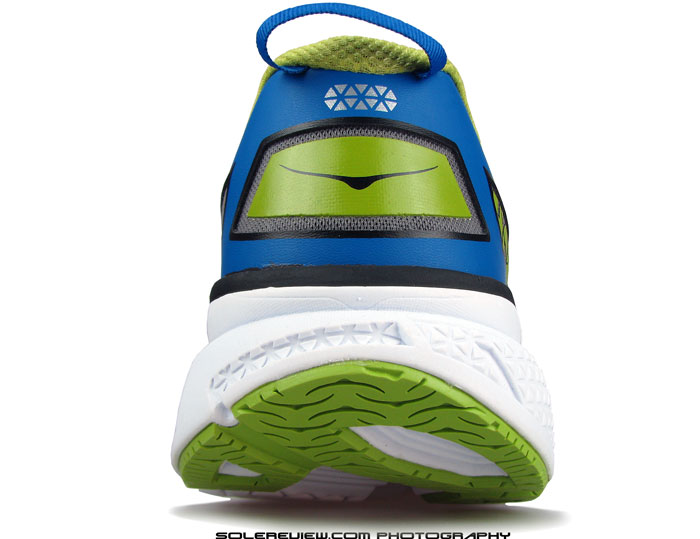
See how the upper heel sits on a flared base. This is where the cushioning magic is. And that shiny silver thing on top? Not reflective, just decorative. While at it, notice the humongous upwards heel spring which results in late rear-foot strike.
When seen from the top, you’ll notice that the midsole wall doesn’t extend straight downwards. The upper portion (around 30% of midsole wall) appears to sit separately on a thicker midsole base, as if they were two different components. This is achieved by a groove which goes horizontally around the midsole, deeper in rear-foot than forefoot. Coming to think of it, even the Nike Pegasus 31 does a similar thing, only with a pronounced lateral bias.
The midsole flare is where bulk of Hoka’s extra foam volume resides, the stack heights being what they are.
This allows the heel area to achieve a more effective ’sink’ into the wider midsole base, increasing responsiveness. There’s also the vertical sidewall groove to be taken into the equation. What happens during a rear-foot strike is the following.
In a behavior typical of rocker sole design, (Skechers GoRun Ride 3 too) foot-strike takes place in mid-stage rearfoot instead of heel edge. When that happens, both the surrounding groove (green dotted line) and vertical groove (red dotted line) come together to make the rear midsole act as a giant crash pad. The upper heel sinks into the rearfoot base, and at the same time, part of lower midsole shifts slightly forward, shortening the width of vertical groove. Sounds a bit complicated, so the captioned image above makes an attempt to explain what’s going on.
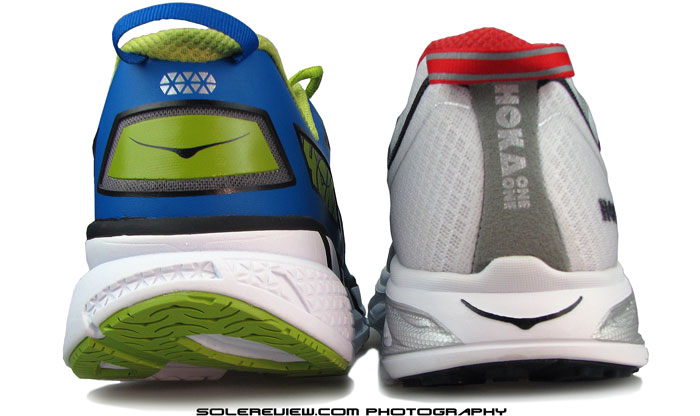
Want a less cushioney, lower drop alternative? The Hoka Huaka (right) might be the shoe for you. Our review in first week of December.
The freedom of heel movement is a double edged sword, as it shaves a few points off when it comes to stability. We call this out not with the intention of describing this as a negative, but to better manage expectations. The Clifton feels stable enough for a neutral shoe with level of cushioning this extreme; but if you seek more stability, you’ll be better off with a lower to the ground (and firmer) shoe like the Hoka Huaka.
Transition is extremely smooth, owing to single density midsole and extended side wrap(s) which Hoka calls ‘Active foot frame’. Naturally, for a shoe this cushioned, ground feel is non-existent, all of which is absorbed by the midsole. The rocker design sole also controls forward movement, with a rigid, minimally flexible front-end tipping the foot forward.
If you’re looking for a high level of under-arch support, the Hoka Clifton isn’t the one to deliver the goods. Yes, the midsole is wide and generally supportive, but that’s a different thing from specifically engineered arch support.
Another great thing about Clifton’s ride? It is undoubtedly the most cushioned shoe we’ve ever tested, but it’s no slouch. Running in them doesn’t seem to sacrifice speed, and this seems to be due to improved economy of transition. A rocker sole results in rearfoot strike instead of heel, and a stiffer forefoot helps roll. That’s the only thing we can think of, as soft soles and good pace aren’t exactly drinking buddies. Ok, the Clifton is no Zoom Streak, but for a shoe of this class, it can take you by surprise.
This gives the foamy invention a lot more versatility than one would expect. Great shoe if you’re looking to do long runs in. Ideal as a daily trainer. The ultimate recovery shoe. If you can live with the snug upper, then this is a shoe which can wear many hats, doing extremely well under multiple sets of expectations or needs.
For a world grown weary of marketing jargons being thrown around with little substance to back, the Hoka Clifton comes as a breath of fresh air. It does with aplomb what the brand says it does, and that is a pretty rare instance. Highly recommended.
(Disclaimer: Solereview paid full US retail price for the shoe reviewed)


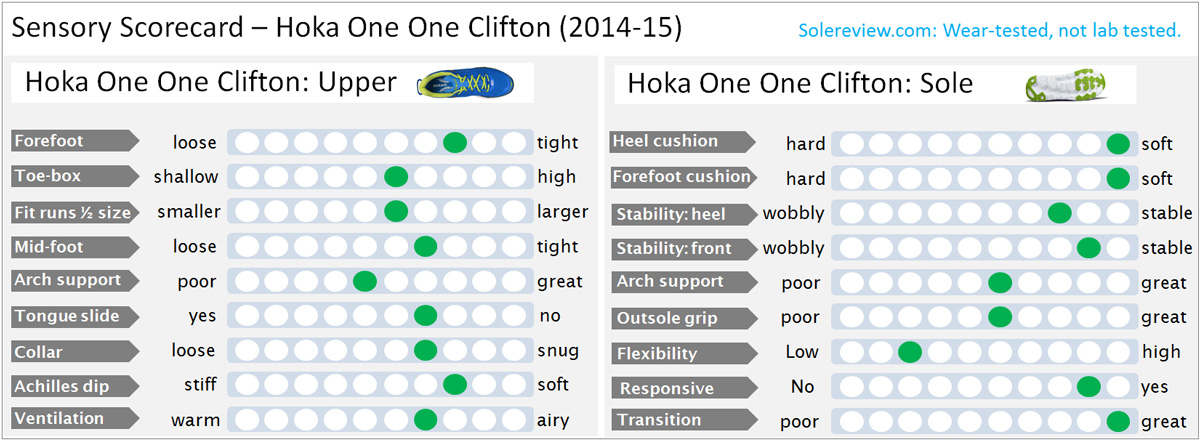
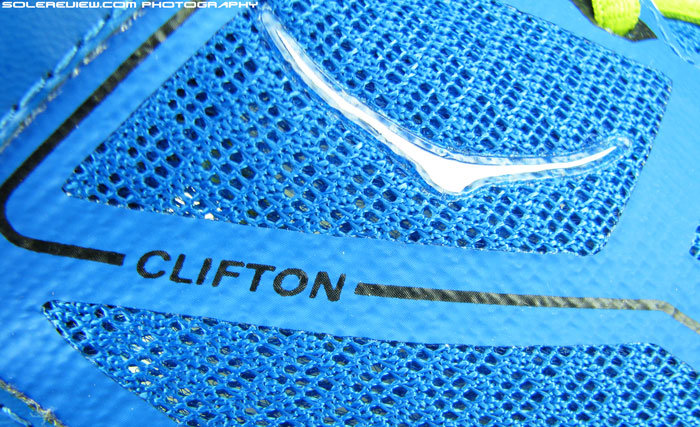
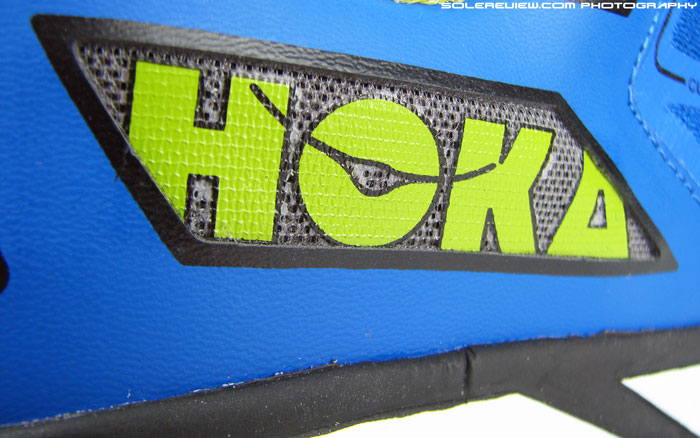
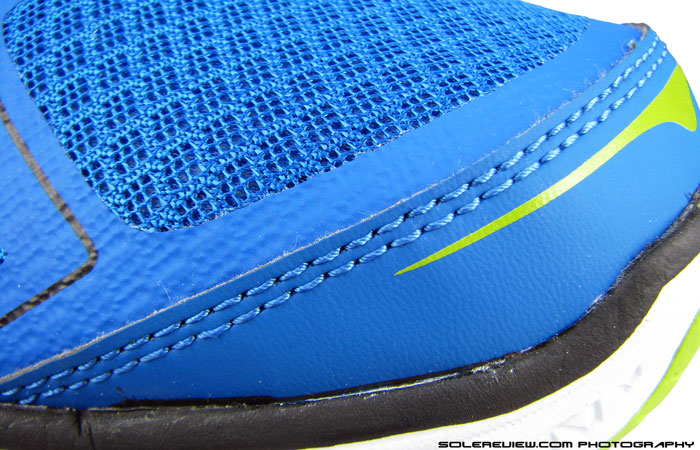
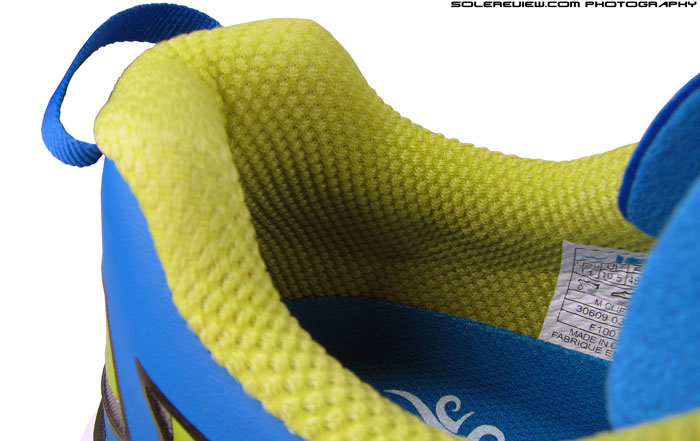
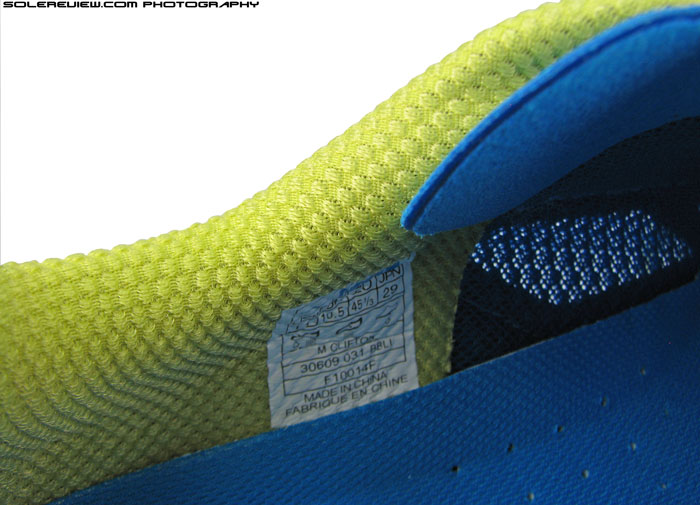
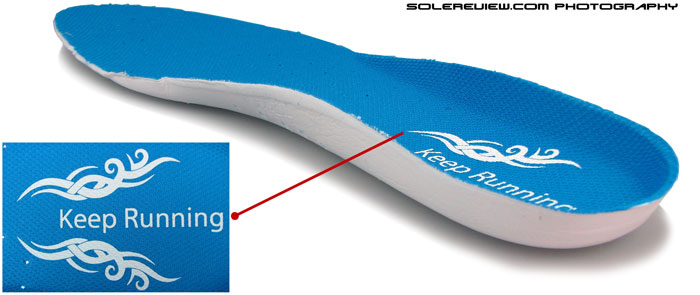
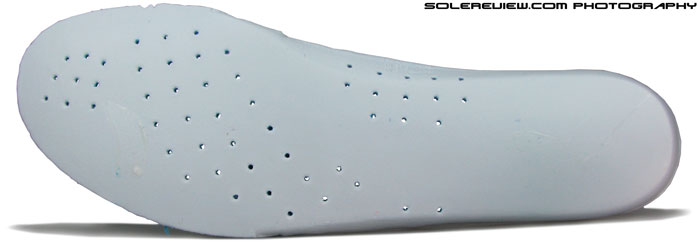
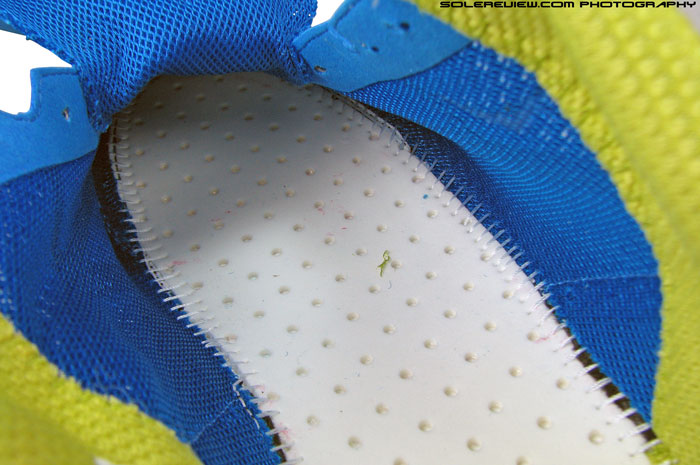
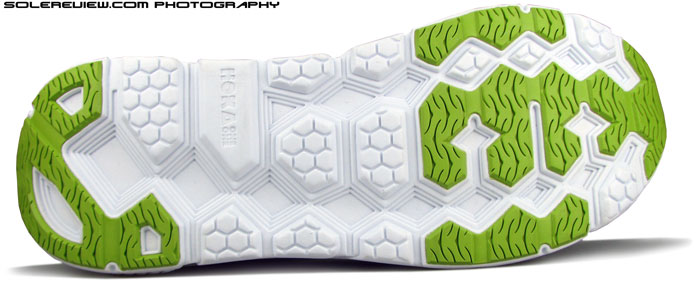
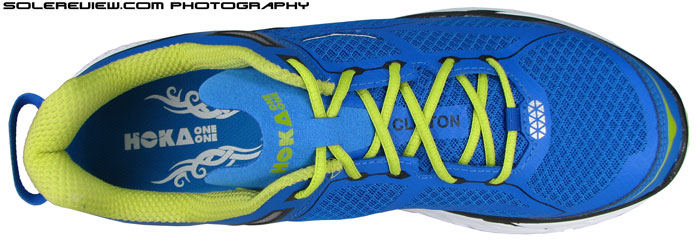
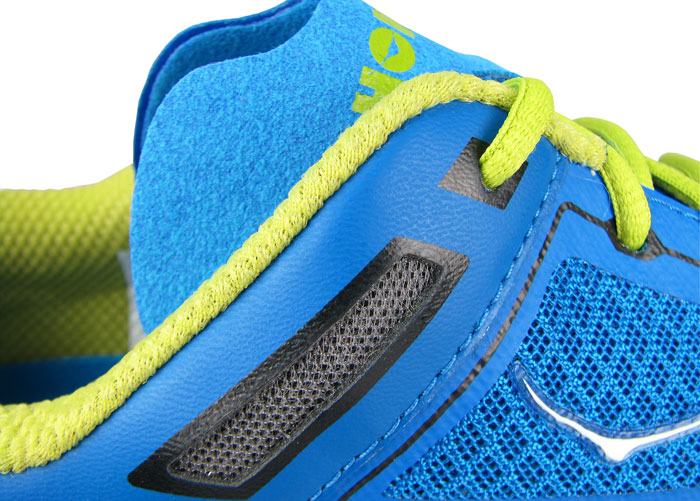
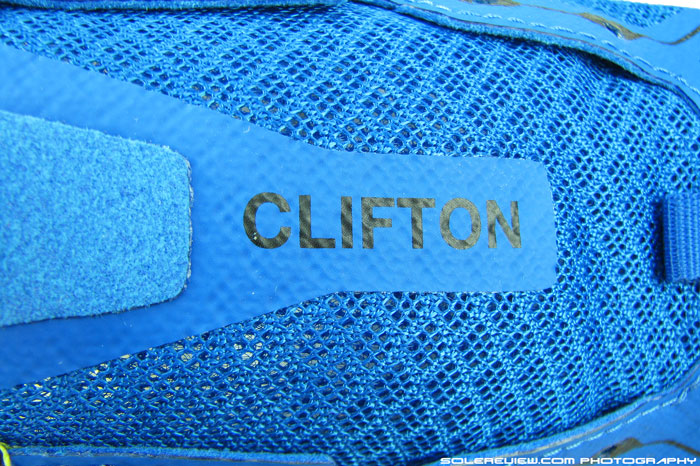
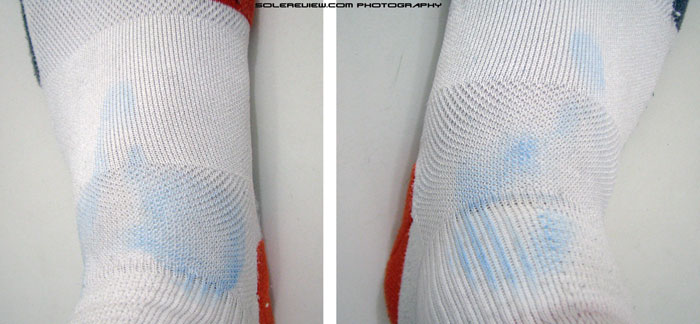
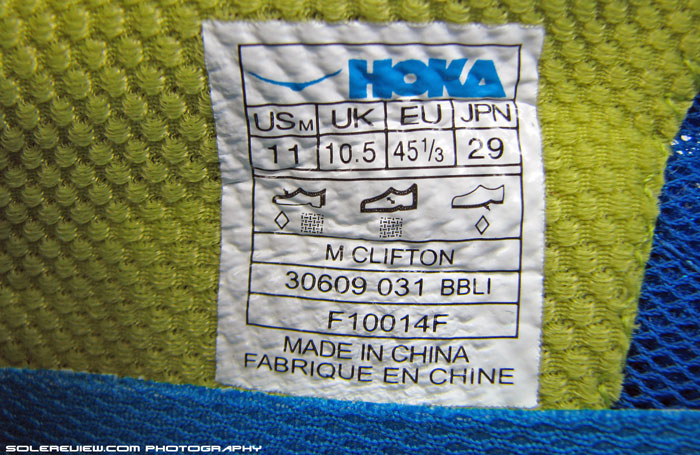
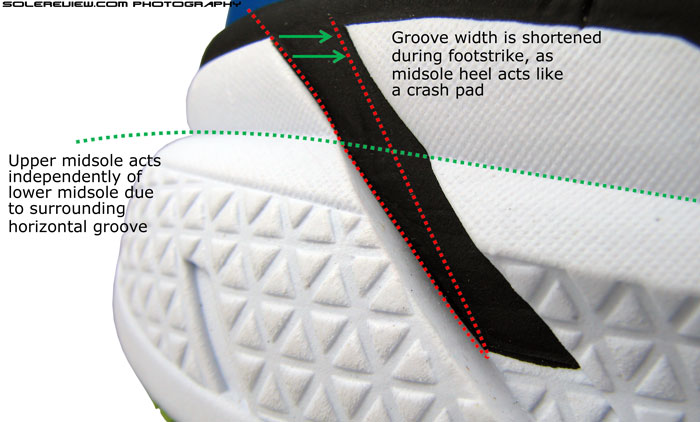
63 comments
Fantastic shoe! At 56 and two knee ops in the last year running had become difficult and intermittent. As a last resort I tried the Clifton after reading a couple of reviews. There is no high street stores in the uk stocking Hoka,so I bought online. Size wise they are the same as my Asics Nimbus, but wider in the foot area which is fine by me. Out the box I was worried although mega light the build quality looked flimsy. Putting them on was like stepping on a foam pillow. My first run was weird as after 35 years of running I have never felt anything like it. The wide cushioning sole is fantastic and with the Rocker sole, it seems to spring you forward encouraging you to run faster. After two months,durability is very good no sign of excessive wear as I thought.
The shoe is not just a medical shoe,it is for the fast 10k to a good marathon training/race shoe. In short the shoe has kept me running I cannot recommend it enough. I Fully endorse your great review.
You posted the comment before we could send you an email notification – we remember you asking for this review a few months ago.
Thanks for sharing your feedback – glad to hear this shoe worked out for you so well!
Epic review, thank you very much. I´m a little depressed right now because the Clifton is too narrow for me :-(
Wish they made widths in the Hoka!
Amen to that :)
Great review, been very interested in these, how do they fair stability wise? I slightly overpronate and currently run in Mizuno Inspires/Asics GT 2002 2’s, Having looked on Hokas website all the road running shoes seem to be neutral, is this the case? or would they be ok?
keep up the great work really good site with insightful reviews.
Check the Conquest out; it’s the most stable of the Hoka’s, whilst still being a neutral shoe.
Or the Huaka & Rapa Nui, they are also more stable/responsive in a lighter package.
Thanks Roger, much appreciated, will wait and see how the review comes out for the Huaka’s, have to order online as there are no dealers anywhere near me, so will be a bit of a gamble, but one that looks like it is worth taking.
Hi Richard,
I think I can offer some insight. I too have mild overpronation and have run in shoes like the Guides, Ravenna, Inspires and the like. I picked some Clifton’s up this past week and put in 60km+ in 4 consecutive days (I never, ever do more than 3 days in a row) of running (25k being the longest in one go); no issues whatsoever! Had I have done that in any of the other shoes I listed, my knees would have been toast after the 3rd run.
Sole Review folks, are you familiar with Pearl Izumi’s Natural Motion line of shoes? Would love to see you do a review to see how similar you think they ride to the Clifton’s (cushioning aside of course). I run in their EM Road M3 and I swear, if you firmed up the Clifton’s ride and dropped the stack heights, you’d have the M3’s; same one piece midsole feel to them with the same unbelievably smooth transition through foot strike due to use of “rocker” geometry. Going fwd, I see the Clifton’s as my LSD and recovery run shoe and the M3’s as the firmer faster tempo/speed day shoe. I’m in heaven!
Appreciate the feedback. Not familiar with Pearl, but thanks for the suggestion. We’ll try to review them in the near future.
Thanks for the feedback, really interesting to hear from others in the same position, may well try the Izumi’s as well now too.
They aren’t any better or worse off from a stability viewpoint, when compared to many neutral shoes. That said, we feel that the GT’s are stabler. Haven’t reviewed Inspires yet, so can’t offer an opinion on the Mizuno.
Yes, all Hoka shoes are neutral. But they come with features which other brands might pitch as motion control. A good example would be the Brooks Transcend vs. Hoka Conquest. Both have these side frames which control forward foot movement. Brooks says that those ‘rails’ control pronation, while Hoka just points out the overall stability aspect.
Our review experience is limited as far as Hokas are concerned. Roger has some great insights below.
Hoka is actually coming out with a stability shoe called the Constant. You can see it on their website.
Also curious to see how the $130 Odyssey is differentiated from Clifton.
Thanks Mark, will have to wait and see what they are like when they come out.
How would this shoe compare to the Pegasus Nike 31? I am looking for a cushioned shoe that is flexible. I find the new Pegasus 31 less cushioned than previous versions (29 and 30) and more stable (less flexible). I am thinking maybe this shoe might fit the bill in that regard (cushioned and more flexible than the 31).
Hi – the Pegasus is more flexible than the Clifton.
The Hoka is more cushioned, yet its high toe spring and thick midsole makes it less flexible. Would rate stability on same level as Pegasus.
I was pretty sure I would buy them but there’s one thing I’m worried about. The snug upper. I have bit wider forefoot and I’m worried that Clifton would be too narrow. How would you compare them to Glycerin 11 or Triumph 11 in terms of forefoot fit and width? I’m currently using Glycerin 11 and they’re a good fit, I have enough space for the full width of the forefoot. But from your description this could be an issue.
You’d have to wait a few days for the answer as Glycerin 11’s are currently not at hand. (To be able to compare)
We’d prefer to give you a specific reply instead of relying on weartest notes.
Thanks guys. I’m also a US11 in terms of size. You continue to impress me with how much you try to help your readers. Will be waiting for your reply. Keep up the great work! :)
Ok, here you go.
Biggest area of noticeable difference between G-11 and Clifton is the place near the head of small toe (lateral forefoot). Inside the Clifton, it seems as if that area of upper is pinning the small toe down. Whereas in the Glycerin, the fit is snug but not overbearing in any way.
The best way to describe this would be easy if you’re wearing a Glycerin 11. Let’s assume you’re wearing the left shoe.
Now locate the tip of your left small toe, and then wedge your left thumb inside the gap between base of your small toe and midsole edge; this should result in small toe being pinned down by the now-shortened upper.
This is exactly how the Clifton feels in the forefoot. Let us know if you need clarifications.
The other small areas of fit difference would be that the Clifton has more space between the big toe and tip of the shoe, and the Glycerin front end is a little pointy compared to the flatter toe bumper of Clifton. If you compare the pictures in our review, you’ll see what we’re talking about.
Great review, as usual. I’m curious, how does the cushioning feel compared to the Adidas Energy Boost?–which, I think, is one of the only other shoes that received a review noting the marketing lived up to the hype.
Thanks. The cushioning differs in a couple of ways –
a) Adidas Boost feels bouncier and responsive compared to Hoka, which feels softer with more ‘sink.’
b) The Clifton has a better consistency of cushioning, meaning the forefoot and heel coming across as balanced in softness. The Energy Boost in comparison feels localized in its cushioning delivery, most of it concentrated in the heel. In that sense, Clifton is smoother in transition.
I had been running in various Nike Pegasus for about 5 years now. I have tried other shoes. However, I always prefer the Pegasus over any newcomer. However, these shoes are different. I ran in them and fell in love. I will use them and Pegasus for now on. I do wish they have a little flex to them. I wonder if that will be in the line up in the future: a Hoka neutral shoe with that great cushioning, light shoe, but with some flexibility. To dream, I guess.
These shoes do what the new Pegasus 31s fail at: consistent cushioning throughout the shoe length from forefoot to heel.
Considering that part of Hoka’s USP is the metarocker design, flexibility might be hard to come by!
I guess my foot will get used to it. I know I do better in flexible shoes. I wonder why that is? Why do some people need flexibility in the shoe and others do not. I know when I run in a stability shoe, I cannot wait to get them off.
Nonetheless, I guess with the Hoka, with all the cushioning, the need for the flexibility becomes more a mute point.
The only problem I ever have is a shin splint that can occur in my left leg only. The more “plush” feel to the shoe, the better it is.
In these Hoka, I have run three days 6 miles each time and no sign of any shin pain.
The past three generations of the Pegasus kept the shin pain in check. However, not so with the Pegasus 31. That version seems to bring it on more than the previous versions.
Thanks for you input and any advice you might be able to provide.
Really hard to say why the Pegasus 31 has made your splints re-surface.
Just curious, do your left and right foot differ in length?
They do.
We have seen and heard of instances where difference in foot dimensions resulted in localized pain. One of our readers had mentioned about a shorter left foot, which was leading to stressed Achilles.
While a qualified podiatrist or GP would be able to offer fool-proof insights (via bio-mechanical analysis), our hypothesis was that difference led to a reduction of heel to toe drop only for that foot, resulting in burden on the Achilles.
It could be similar in your case, except that the varying forces end up causing shin splints. That said, always better to get an opinion from a Podiatrist.
I should ask: does any shoe come to mind that has close to the level of cushioning as the Hoka but with some flexibility retained in the design and use of materials?
The only shoe which comes to our mind is the Brooks Transcend. Absolutely not in the same cushioning league as the Hoka, but displays similar foam character, albeit at a lower level of performance.
There’s a bunch of new Hokas lined up for a Spring release; who knows, those might feature more flexibility.
I have now run in the Cliftons for two weeks and have put 40
miles on them. Without a doubt, these
are the best shoes I have ever run in.
No shin pain at all in these shoes.
For years, I have relied on Nike shoes.
The best for me were the early Vomero and the 27 to 29 Pegasus.
Hands downs, the Clifton might be the best neutral full
cushioning running shoe on the market.
What is most concerning to me, in regards to Nike, is both
the Vomero and Pegasus have become stiffer in cushioning in recent
renditions.
Nike has a huge line of shoes. Why is it Nike cannot have ONE shoe that is
neutral and also has plenty of “cushy” but supportive cushioning as the
Clifton. Again, Nike has so many
different shoes, but it does not have a shoe anymore for the neutral running
that demands a high level of cushioning.
Nike is missing out in a certain segment of the neutral running.
I hand it to Hoka for taking care of us. At this point, I am done with Nike. There current Pegasus has nothing on its past
nor on this Clifton.
Please tell Nike they really are missing a neutral shoe in
their lineup. A shoe that used to be the
early years of the Vomero and 27-29 Pegasus.
Tell Nike the Clifton has found a missing niche that all other shoe
companies have forgotten.
My only complaint, since I do tend to run at night, is they
need to be some reflective elements on this shoe. Why would there be none at all?
Thanks for the feedback.
Yes, the earlier Vomeros were something (2008 version in particular), though you’ve corrected observed that there’s nothing in the current Nike line which delivers all around plushness. They will pretty much do their own thing unless business takes a serious dive. Nike has enough marketing money to make even an average shoe sound like it’s the best show in town.
Hoka is coming up with many models next Spring, so hopefully uppers should see improvement, including reflectivity.
It is nice to read comments exactly the same as how I feel. The vomero 4s and 5s were my all-time favorites, with the Pegasus 27-29s a close second. I will try the Cliftons, although I believe the Clifton 2s are coming out in July with some of the changes in the uppers suggested in this review.
Just bought the Cliftons because I was curious more than anything–have been running in Flyknit Lunar 2s and really like them. thoughts on what to expect, what show would be best for what types of runs? thinking of adding zoom streaks or T7 racers for faster stuff.
Clifton is all about no-holds barred cushioning. But at the same time, it pulls through on long distance runs without negatively affecting pace. Flyknit Lunars are comfortable, but the cushioning levels are regular, though a bit more responsive than the Clifton.
Yup, shoes like the Zoom Streak (or even the adios Boost) do well on fast runs. Haven’t reviewed the T7 yet, so no opinion at this time.
I received a few days ago my (first) pair of Hoka Clifton.
After reading your review (and thanks for your tip after a question I made), knowing the new Pegasus 31 are less cushioned than previous versions (and I need a good cushioned shoes) I decided to try the Cliftons.
I am a “new” runner, started to run last year, and was running with a pair of Nike Pegasus 30. Usually, after some days of hard running my feets suffers the work, and some pain in my heels is common to me. My average monthly running is between 120-200 Km.
My first impression with the Cliftons was of comfort, I mean: the Pegasus are highly comfortables, but the Cliftons feel even better.
I did a couple of 10k runs until now, and in the first one, I beat my current personal “record” (47′ 20”, from the Nike 10k a couple of weeks ago), improving my time in 20 seconds! Nothing bad for a training running after a day of work (until now, my best training running for 10 k was 49 min. with the Hoka my first time was 47min.)
The shoes feels very light (and are very light indeed), and during the run, it seems that the rocking chair effect helps you to move forward efforlessly.
This is just my first impression after a couple of runs, but it seems I will be a new fan of Hoka shoes from now on.
The suggested improvement of some reflecting parts will be something to expect in future models.
Glad to hear you had a positive experience with the Cliftons, and thank you for sharing your feedback. Yes, there are much more cushioned than the Pegasus 30, whic itself was very soft to begin with.
Hoka has a whole new range lined up for 2015, so hopefully those come with minor improvements like reflectivity.
Thanks for your review. The one thing that’s made me hesitate about the Cliftons, and really all Hoka shoes, is their relatively narrow toe box. I don’t have wide feet, just outer toes that are feel limited by Hoka’s. While the Hoka design has been adjusted for America feet, broadly speaking, the rapid rolloff of the toe box reminds me of French (and Italian) shoes.
Btw, do you review Altra’s? The Olympus strikes me as something of a parallel to the Clifton’s in terms of cushioning, although a 3 oz. heavier.
Hopefully Hoka will change their last soon, which could bring some fit relief in forefoot.
Altras are on our mind, but only after we go around the block once with mainstream (and more popular) models.
I have always worn Asic Kayano 20 and lower, I am wondering if the Clifton will serve a 200lb 6 foot 1 runner better in reference to speed, distance runs, and durablity (natural stride). Or would you recommend the Nike Pegasus 31, Saucony Ride 7, or my current shoe?
This is how it breaks down based on our experience.
Outsole durability from high to low: Pegasus 31, Kayano 20/Ride 7, Clifton.
Cushioning level from high to low: Clifton, Pegasus, Saucony Ride 7, Kayano 20.
Quality of transitions for distance runs: Ride 7, Clifton, Kayano 20 and Pegasus 31.
Suitability for speed runs: Ride 7, Pegasus 31, Kayano 20, Clifton. (although we haven’t noticed Cliftons to slow down pace)
You would need to decide what’s more important to you, and prioritize.
Thank you for your feedback, I just dont understand how the pegasus 31 and ride 7 are rated higher then the Clifton. Since everyone says it is the best shoe for everything including comfort, including your review.
A couple of reasons:
a) Our ratings mechanism has evolved since the Pegasus and Ride 7 was reviewed.
b) Our score includes 16 different attributes (which is not shown here). Besides, the Clifton has a not-so-good upper quality, which also influences the score.
I broke down and bought the clintons, my experience is that you can improve your 1-3 mile paces (rocker design does help), but after that your energy feels zapped, its hard to explain, I normally can maintain a good pace throughout a 10K but not in these, again my first three mile times improved but the last half of the 10K times did not. Note: I do run on hills and I think the added shoe height and lack of upper support adds pressure to your ankles.
I ordered the kayano 20 lites and they have a more narrow toe box then my regualr kayano 20s. My regualr Kayano 20s are extremely comfortable.
My option at this point is to try the Pegasus 31 or the Ride 7s. In you expert opinion which shoe out of my two choices are more comfortable overall. The Cliftons have more cushion, but my Kayano 20s are more comfortable (I think the lack of upper support from the Cliftons do play a part).
Finally, IMO your leg energy gets zapped because you dont have any bounce in the cliftons but you do have the rocker motion working in your favor, but that only helps for so long, and on flat surfaces or downhill.
Appreciate the feedback. Shoes behave very subjectively – so what we experienced might not hold true for you, and vice versa. Throw in some variables (like a hilly terrain) and things can change fairly quickly.
While we haven’t worn the Kayano Lite-show version, our experience with similar shoes (Nike Lunarglide Shield) tells us that adding water resistant and additional reflective elements result in a thicker upper, and hence narrower fit.
The Pegasus is also soft (of course, not as much as the Clifton), so perhaps the Ride 7 would be better suited in your case.
No, we did not get these insoles! Maybe it is a new thing.
Hi Jeff,
Thank you for the comment, and for the kind words. The fact that we buy all the shoes influences our reviews from an end-user’s point of view. We do spend a sizeable sum of money on shoes each month, so a good shoe is like getting a good deal, and the other way around. This buy-approach also allows us freedom to decide our own posting schedule, which is great.
Sorry to hear your unpleasant experience with counterfeits – nowadays some of them are so good, they are nearly impossible to tell just by looking at the pictures online. Hope you are on your way to recovery now.
Your requirement is that of a highly cushioned, durable and roomy (forefoot) shoe, so unfortunately the Clifton needs to be struck off that list. The Hoka has a cramped forefoot, and its outsole is definitely sub-par with regards to durability. The build is certainly flimsy as you put it.
Given that, the options we see are the Pegasus 31 and Saucony Triumph ISO, both in wide.
And the faulty shoe you bought it online – was it the Kayano 20, or some other shoe? We say that because the Kayano 21 is softer than 20, in case you were talking about two different shoes.
Thanks for reading my long comment and taking the time to write
a nice reply.
The counterfeits were New Balance, I forgot which model
though, and I threw them out. I’m staying extra alert since that experience. I’m
doing better now, hopefully on the way to a full recovery, thank you =)
Oh, same problem with getting hold of a wide size in the
Pegasus 31 or Saucony Triumph ISO!
What’s your take on the Pegasus 29 as I am still able to get
some from an online store? I read multiple opinions on the net that they are
wider, softer, and plusher than the 30s (and of course the 31s).
I was interested in the upcoming Hoka Challenger ATR or Hoka
Odyssey which are being pushed by some Hoka fans as essentially modified
Cliftons, but who knows if the forefoot will still be cramped, and if the build
quality and outsole will be improved with the excellent cushioning and softness
being retained.
Sorry for the delayed response. Thought we had replied to this comment. Apparently not!
We haven’t tested the Pegasus 29, so can’t say anything about the upper fit. What we can be sure about is the ride, which is certainly plusher/softer than the 31. There should be no difference between the 29 and 30 when it comes to cushioning, as they appear to share the same sole design.
We will be reviewing the Hoka Bondi 4, Vanquish and Constant soon. The Odyssey does seem to be a Clifton spin-off, so we don’t see value in reviewing them. Have to say, Hoka’s line is getting messed up and confusing by the day.
No problem. Thanks for getting back to me =)
Look forward to seeing your upcoming reviews on the new Hoka range (very confusing I agree).
I am 6’4″ and 250 lbs and run about 3-4 miles a day. Looking at Hoka Clifford’s or Saucony Triump 11….any suggestions?
Get yourself fitted with both at a LRS and see how they feel. The Clifton has a lot of mush in the midsole, so you need to see whether there is a trade-off with stability at your body weight.
The Triumph ISO might not feel as soft as the Hoka, but should be stabler.
Also know that the Clifton fits very narrow in the forefoot, whereas Triumph has a relaxed fit in the front.
Hi solereview and other readers. I have a bit of a testimonial for the Hoka Clifton, a bit of a plea for that toe-box widening and, a bit of a vote for the Skechers GoRun Ultra as an option. In October of 2014 I ran the Marine Corps Marathon in the Cliftons and in April I ran the NJ Marathon in the Skechers GoRun Ultras. The level of cushioning in them is quite similar and I am certain that cushioning is what enabled me to amass over 1,100 miles in 2014. Previous single-year high was half of that (~500 miles). I did OK with the Clifton’s narrow-er toe box but it got close to being a problem. Right now I go back and forth between the 2 and it’s really noticeable how much more narrow the Clifton is after wearing the GRU. And it’s really not a case of offering wider widths for Clifton, that only makes the entire shoe wider and you lose the snugness in the mid-foot. It’s just that toe-box shape, it just needs to fan out a bit to allow those toes to splay! Hopeful that Hoka will make some of that toe-box widening this year because everything else was what the doctor ordered: lightweight, rocker geometry, max-cushioned, moderate drop. The New Balance Fresh Foam missed the mark and we are waiting on the new Boracay and Zante. Curious if anyone else has found better options in this category?
Thank you for the feedback, bill.
There has been a flurry of new Hoka launches this year, and hope one of them makes amends in the toe box. The fit is an issue, indeed.
If the Zante is anything to go by (read our review), then the Boracay should be one up over the original 980. We’re also curious to see how the Asics 33M feels – that’s another model which looks like a Hoka clone.
Hi solereview, quick update. I tried the Asics 33M. Yes they are in the max cushion classification and boy, they really got the toe box thing right! Great shape. However, for me, too heavy and not flexible. Since I have been using the Hoka Cliftons and the GRU’s, I’m really spoiled by their flexibility and lightweight profile. So my search continues! If I could only port that M33 toe-box design to the Clifton!!
Thanks for the feedback! Yes, we were surprised by how heavy the 33M is – actually all three shoes FA and DFA are too.
Update: Our recent Hoka buys came with the pictured insole!
I am looking for a pair of shoes for long runs. I am interested in these and wanted to know how they compare to the New Balance Boracays. Any thoughts?
The Clifton is far more cushioned. It also has this rocker sole design, which leads ti the transition behaving very differently from the Boracay.
On the flip side, the Clifton upper is way too snug – New Balance is better than way.
Hi Solereview,
Thank you so much, very useful.
I’ve tried Clifton last weekend. I like almost everything of Clifton except narrow toe box.
I would like to buy HOKA shoe that have Clifton feeling with wider toe-box.
Hello Nat,
The only Hoka (out of what we’ve tested) which has a wider toe box is the Hoka Constant, but it rides firmer than the Clifton.
I received the additional insoles too.
Comments are closed.